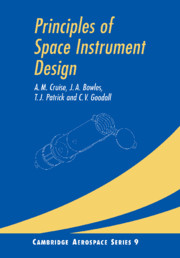Book contents
2 - Mechanical design
Published online by Cambridge University Press: 12 November 2009
Summary
For spacecraft and their instruments, the engineering disciplines of mechanical and structural design work together, and both are founded on the study of the mechanics of materials. We create designs, then prove (by calculation and test) that they will work in the environments of rocket launch and flight. Mechanisms, by definition having relatively–moving parts, are not the whole of mechanical design; they are interesting enough to get a later chapter of this book (Chapter 5) to themselves. But any mechanism is itself a structure of some kind, since it sustains loads. We therefore define structures, which are more general than mechanisms, as ‘assemblies of materials which sustain loads’. All structures, whether blocks, boxes, beams, shells, frames or trusses of struts are thereby included.
Mechanical design should begin by considering the forces which load the structural parts. The twin objectives are to create a structure which is (i) strong enough not to collapse or break, and (ii) stiffly resistant against deforming too far. The importance of stiffness as a design goal will recur in this chapter. Forces may be static, or dynamic; if dynamic, changing slowly (quasi–static) or rapidly, as when due to vibration and shock. The dynamic forces are dominant in rocket flight, and vibrations are a harsh aspect both of the launch environment and of environmental testing, generating often large dynamic forces. To analyse each mechanical assembly as a structure, we shall need the concept of inertia force to represent the reaction to dynamic acceleration.
- Type
- Chapter
- Information
- Principles of Space Instrument Design , pp. 13 - 72Publisher: Cambridge University PressPrint publication year: 1998

